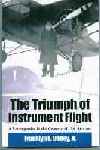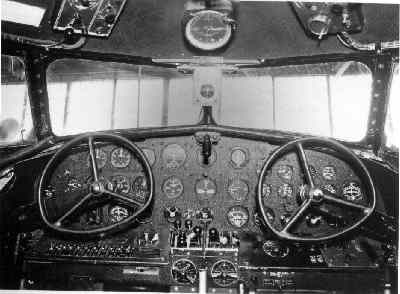
- Barnstomers and Early Aviators
- Budget Flying Clubs
- Aviation Records
- VFR to IFR
- Early Airline Development
- Flight Across the Atlantic
- P-40s to Iceland
- Alaska Based Navy P2Y-1's
- Buckner Goes to Alaska
- Ship-to-Ship Battle
- Naval Flight Training
- NAS Instrument Training
- Aleutians Anti-Submarine Warfare
- Search & Rescue
- Gyros and Flight Computers
- Baseball Team Lost in Flight
- Tomcats and Boeing 777s
Aviation History: "Instrument Flight" overcame weather. Sperry gyro instruments for horizon, attitude and direction. On pilot's panel by 1931
Copyright 2013 Contact Author
Most of the pages in the flying story contained in the book whose cover you see at the left, are devoted to actual experiences from all sectors of aviation. I bring readers into the cockpit. I hope they will enjoy adventure and a(my) learning experience. This is not a "how to" book. In the few instances where technology is pivotal, I try to keep it simple.
Another aviator's book is referenced for the birth of his airline. He is Robert Mudge and he is still (2013) living in Massachusetts. There is more about him in Northeast Airlines' Yellowbird; memorable moments Boston-LaGuardia by author/pilot Robert Mudge or scroll down the left column to Moments of Terror.
A Catalog from the Hagley Museum (cover picture below) proved to be a key source for the introduction of the Sperry instruments that demonstrated, by their performance in service for a trained pilot, the basic solution to instrument flight.

The Hagley Museum in Wilmington DE misspelled my first name (it is Franklyn) in their mailing. Not important. This trade catalogue contains aviation history! On page 3 of the catalogue, one of the word challenges in aviation history, introduced by the Smithsonian, was cleared up for me. September 1929 was the month in which "Lieut. James H. Doolittle took off under a hooded cockpit, (at Mitchell Field, Long Island) circled the field and landed without once seeing outside the airplane." Many have concluded that this was the first instrument flight. The Smithsonian account relates that there was a safety pilot aboard, who was not under the hood. That was key to the 'blind' flight. We may never know who made the first instrument flight. My book provides much more detail on how instrument flight came to aviation.
Readers of the book will discover that Lawrence Sperry, Elmer Sperry's son, demonatrated that the 'makins' for instrument flight existed a decade before the 'solution' came to the instrument panel.
For those who already have the book, I will send FREE , an Addenda to the book, that clears up the Doolittle mystery, and also a mystery letdown that Lindbergh made on his Sirius flight to the Orient. The "Contact Author" link at the top of each page on this website contains an up to date e-mail address that will reach me.
The "retrospective" word in the subtitle for the book is an indication that a crtical need that was fulfilled in aviation's history has been brought to life in a way that connects the dots. For the first time, we can now see that two principal threads in flying, each beginning within a few years of the other, came together and set the stage for the aviation industry that we know today. I will leave to readers of the book to discover what that juncture was and how an essential threshold was then crossed. That portion of the published book, in terms of word volume in comparison with the actual adventure experiences, is small, but essential.
First, what is instrument flight? Instrument flight is flying with no earth horizon as a reference. Why is that important? Without the ability to control the flight of an aircraft, from takeoff to landing, despite clouds, haze, smoke, snow and other obscurations to earth and particularly without earth's horizon reference, the progress of aviation, strong in its first three decades, would have been completely stunted. In 1929, the newly formed airlines' planes took off in the morning when the weather permitted. They would land in the afternoon and put passengers on a train for the night. The competition was still rail.
The sight of the Rail Conductor leaning out of a rail passenger car, Hamilton watch in one hand and lantern in the other, signaling the Engineer to leave the station, has been repeated millions of times, with almost never a delay for the weather. Air travel needed a way to "leave on time." Some solution to clouds and rain and snow and fog had to be found. Air travel now does leave on time with respect to non-violent instrument weather. So, most folks in the generations born since World War II are not likely to have ever seen that Rail Conductor.
The Wright brothers built and flew the first successful powered airplane in December 1903. In all essential aspects, the Wrights had it right. They needed lift from the wings. To obtain lift they needed a motor to create forward thrust. Just as important, they needed flight control and they got it from flight control surfaces. As pilots, the Wrights exercised intelligent flight control by visual observation of the earth beneath them. Their elevator and their rudder were their flight control surfaces.
Glenn Curtiss came along just a few years after the Wright brothers. The Wrights had developed mechanical expertise in the bicycle business. Curtiss had been building motorcycle engines. Curtiss was able to add power to the airplane engine. Curtiss and the Wrights became competitors.
Early flight control surfaces are visible on Glenn Curtiss' "June Bug" aircraft pictured in the book. Upfront is the elevator and behind the pilot was the rudder. Curtiss was later persuaded to put the elevator back with the rudder, where we see it today.
The Wright brothers knew they needed a flight control to counteract the tendency of their airframe to roll to one side or the other. This was accomplished by whichever brother was flying the plane, who as pilot was lying prone on a bottom wing which could flex. Aided by moving his own weight, the pilot could literally warp the lower wing to help control the tendency of the craft to roll from side to side. They had designed their wing to achieve a crude form of aileron control.
Just a few short years after the Wrights' first flight in 1903, Glenn Curtiss improved on wing warping by providing the triangular sections at the end of the wing of his "June Bug," the early "aileron." After the Wright's "elevator" and "rudder," this "aileron" became the third discrete flight control surface. Curtiss moved the aileron by leaning his shoulders left or right to move an actuating cord that stretched beside him in his pilot seat.
The French completed the basic flight controls by giving the pilot foot pedals to control the rudder, and a "stick" to control elevator and aileron. In the meantime, Curtiss had added not just power but also reliability to the engine.
Most important for this flying story, aircraft now had three flight control surfaces and the means to move them. In clear weather, pilots used their visual sight reference to move the flight controls for safely conducted flight.
The retrospective then moves to World War I, then to airmail flying using light beacons for navigation, and then into the third decade of the 20th century, particularly the years 1927-1931. Lindbergh flew the Atlantic to Paris in 1927. He kept awake for 33 hours. Just as important, his radial air-cooled engine kept humming for those 33 hours. Some speculated that the flight was a fluke. Although he did not have the navigation tools to fly great circle navigation, he accommmplished that result by flying a series of chords to approximate a great circle. Without that wisdom, he did not have enough gas to make Paris from Long Island. For this and many other reasons, Lindbergh's accomplishment was huge.
In early sections of the book, the reader gets a brief glimpse of the author's first introductions to aircraft, up close. A Curtiss Jenny story is followed by the author's 1929 ride in a Stinson Detroiter, piloted by early aviator, Russell Holderman, at the Leroy, New York airpoirt. What follows is safe instrument flight, commercial aviation with passenger airlines, and corporate aviation.
But it was the Lindbergh feat of 1927 that provided the impetus for a dedicated group of aviation enthusiasts, some daring, some cautious, and some who blended daring and caution in the right mixture. Month by month in the years 1929-1931, pilots shattered endurance records, one week in the air, two weeks in the air, and more. Other pilots, men and women, month by month, set new point to point speed records.
Consider the National Air Races at Cleveland in 1931. Lowell Bayles of Springfield beat out Jimmy Doolittle for the coveted Thompson Trophy. Bayles was flying the GeeBee, designed and built by the Granville brothers.
St. Louis, Los Angeles and Texas provide stories of early success. Tokyo and Wenatchee, Washington share a story of achievement. Lindbergh makes another important and revealing flight, this time with his wife, Anne. The years 1929-31 provided a plethora of record-making and record-breaking flight events.
For the progress of aviation, the speed and endurance feats were much more important than winning the race or setting a record. Designers and pilots were establishing the aircraft as a reliable, high performance device. All were making history, though in the acclaim of records, some may not have realized the true impact of their feats.
Collectively, these men and women proved that aviation was here to stay. It would change the history of the world in many ways. The subject of instrument flying would never have become relevant if aircraft had not achieved reliability, and flying them more than a novelty.
While the Wrights and Glenn Curtiss and Igor Sikorsky and the Granvilles and those who flew their aircraft were moving the chalks, so to speak, from novelty to practicality, two brothers and their father had been working in a Long Island laboratory, and with demonstration aircraft, on their vision of an autopilot for aircraft. Their contribution would have the potential to lead to published schedules for air transport departure times, and then, despite clouds, rain and even fog, getting aircraft off at published departure times.
A Lockheed Electra 10 instrument panel shown here demonstrates the steps that were needed.

The crucial steps that remained after the early Sperry Gyorstabilizer was demonstrated took a few years. The spatial attitude and direction functions were ferreted out of that stabilizer and put into instruments on the panel a where a pilot could see them, and understand what they were telling him. That step from concept to realization is the crux of the story in this book.
The ultimate blind landing anticipated by Lawrence Sperry in 1914 was still 80 years in the future. It came into being in the last decade of the 20th century in the Boeing 757-767-777 series of transport aircraft and in military aircraft. Airline pilot Robert Mitchell helps us understand that accomplishment.
When the gryo horizon and the directional gyro instruments came to the pilot's panel, and ground/air radio aids to navigation replaced light beacons, instrument flying became the foundation for aviation's future.
Men, women, and their flying machines then went on to enliven the story told in the book, "The Triumph of Instrument Flight: A Retrospective in the Century of U.S. Aviation..
Home | Joi"ning the War at Sea | The Triumph of Instrument Flight